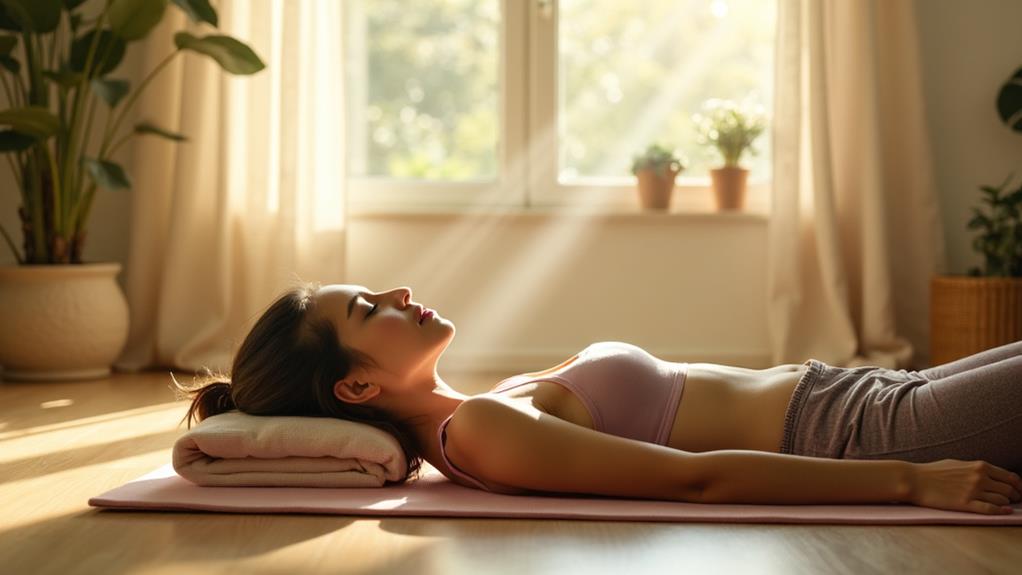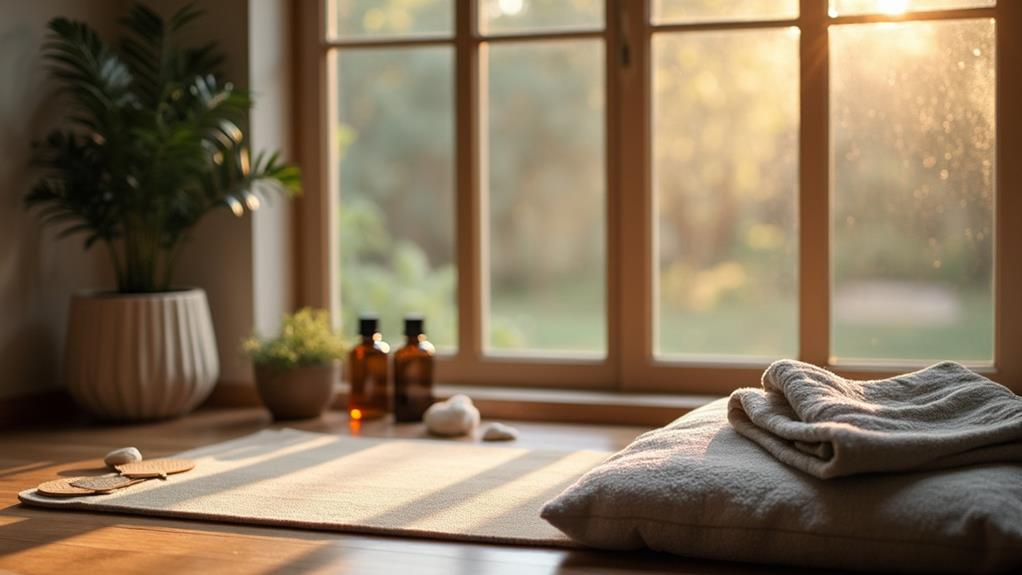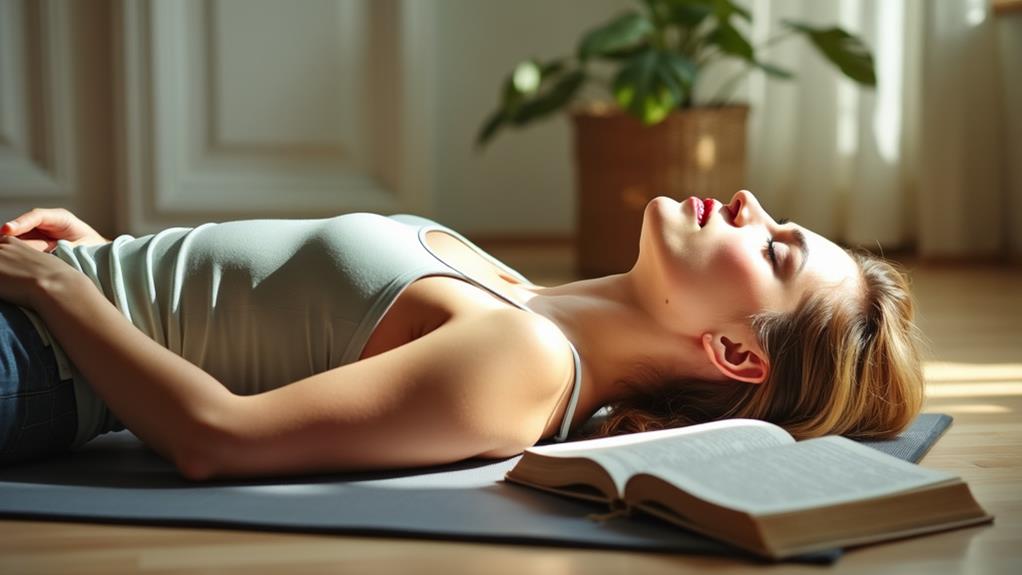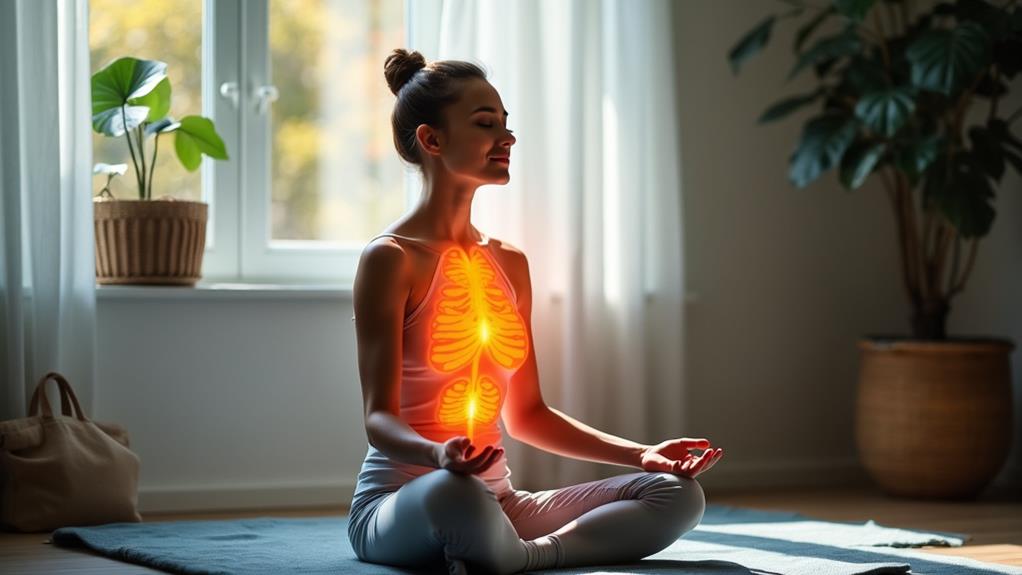You might find that stress has a way of creeping into your daily life, making it hard to relax. Progressive Muscle Relaxation (PMR) offers a structured approach to help you manage this tension effectively. By focusing on tensing and then relaxing different muscle groups, you can create a sense of calm that permeates your entire body. But before you jump in, it's essential to understand the right preparation and technique to maximize your experience. Discovering these details could be the key to transforming how you cope with stress.
What Is Progressive Muscle Relaxation?

Progressive Muscle Relaxation (PMR) is a powerful technique designed to help you reduce stress and tension in your body. It's rooted in the history of relaxation techniques developed in the 1930s by Dr. Edmund Jacobson, who believed that muscle tension and anxiety were closely linked.
By focusing on muscle awareness, PMR encourages you to systematically tense and then relax different muscle groups, promoting a profound sense of physical and mental calm.
To practice PMR, find a quiet space where you can sit or lie down comfortably. Start by taking a few deep breaths to center yourself. Then, move through your body, beginning with your feet, tensing each muscle group for a few seconds before releasing.
Notice how the tension melts away, leaving you feeling lighter and more relaxed. Continue this process up through your legs, abdomen, arms, and face.
As you practice, you'll become more attuned to your body's sensations. This heightened muscle awareness can help you recognize stress signals earlier, allowing you to respond proactively.
PMR's structured approach makes it accessible and effective for anyone seeking relief from daily stress.
Benefits of PMR for Stress Relief
Using Progressive Muscle Relaxation (PMR) can greatly benefit your stress relief efforts. This technique not only helps you unwind but also provides tangible physical and mental benefits.
As you practice PMR, you'll likely experience:
- Reduced Muscle Tension – By systematically tensing and relaxing each muscle group, you release built-up tension, leading to a feeling of lightness and ease in your body.
- Improved Sleep Quality – The relaxation you achieve through PMR can help you fall asleep faster and enjoy deeper, more restorative sleep, which is essential for overall well-being.
- Enhanced Mental Clarity – As you let go of physical stress, your mind clears, allowing for better focus and concentration in your daily tasks.
Incorporating PMR into your routine not only promotes physical benefits by easing tension but also fosters mental clarity, empowering you to tackle stressors with a refreshed perspective.
When you consistently practice PMR, you'll find it easier to manage stress, leading to a healthier, happier you. Embrace this powerful tool and witness the positive changes in your life!
Preparing for Your PMR Session

To maximize the benefits of PMR, it's important to prepare your environment and mindset before you begin. Start by finding a quiet, comfortable space where you won't be disturbed.
Make sure the lighting is soft and the temperature is comfortable, as these factors can greatly enhance your relaxation experience.
Next, consider what you'll wear during your session. Loose, comfortable clothing can help you focus on your muscle awareness without distractions.
It's also helpful to remove any tight accessories that might hinder your ability to relax fully.
Once your session environment is set, take a moment to clear your mind. You might want to sit or lie down in a position that feels natural to you.
Close your eyes and take a few deep breaths, allowing your body to settle.
Step-by-Step PMR Technique
Begin your PMR session by focusing on one muscle group at a time, starting from your toes and working your way up to your head. This technique helps you recognize muscle tension and encourages a deep relaxation response.
Here's a simple step-by-step guide to get you started:
- Toes: Tighten the muscles in your toes for about five seconds, then release. Feel the difference between tension and relaxation as you let go.
- Calves: Move up to your calves. Squeeze the muscles tightly, hold for a moment, and then relax. Notice how the tension melts away.
- Thighs: Engage your thigh muscles next. Press them together, hold, and then release, allowing your body to sink deeper into relaxation.
As you progress through each muscle group, remember to breathe deeply and focus on the sensations.
Common Mistakes to Avoid

When practicing Progressive Muscle Relaxation (PMR), it's easy to fall into some common pitfalls that can hinder your relaxation experience. One major mistake is succumbing to misconceptions about PMR, such as thinking it's only about tensing and releasing muscles. While that's important, the focus should also be on mindfulness and being aware of how your body feels during the process.
Another common error is improper muscle focus. It's essential to target the correct muscle groups, as neglecting certain areas or overemphasizing others can lead to frustration. For instance, if you skip the shoulders or neck, you mightn't fully release built-up tension, defeating the purpose of PMR.
Additionally, rushing through the process can undermine its effectiveness. Give yourself time to truly engage with each muscle group, allowing for a gradual shift from tension to relaxation.
Integrating PMR Into Your Routine
Incorporating Progressive Muscle Relaxation (PMR) into your daily routine can profoundly enhance your ability to manage stress. By creating consistent habits, you'll find it easier to unwind and recharge.
To make PMR a part of your life, consider these key steps:
- Set Daily Reminders: Use your phone or calendar to alert you at specific times to practice PMR. This helps establish a routine and guarantees you won't forget to take that much-needed break.
- Choose Ideal Environments: Find a quiet place where you can comfortably sit or lie down without distractions. Whether it's your bedroom, a cozy corner in your living room, or even a peaceful outdoor space, the right environment can greatly enhance your relaxation experience.
- Start Small: Begin with just five minutes a day. As you grow more comfortable with the technique, gradually increase the duration. This way, you'll avoid feeling overwhelmed and can seamlessly integrate PMR into your lifestyle.
Enhancing PMR With Breathing Exercises

To truly enhance your experience with Progressive Muscle Relaxation (PMR), integrating breathing exercises can make a significant difference. By combining PMR with effective breathing techniques, you can deepen your relaxation and release tension more efficiently.
Start by focusing on your breath. Inhale deeply through your nose, allowing your abdomen to expand. Hold that breath for a moment, then exhale slowly through your mouth. Repeat this for several cycles, letting each breath ground you further into relaxation.
As you breathe, visualize a calming scene—a peaceful beach or a serene forest. This visualization method not only distracts your mind from stress but also complements the muscle relaxation process.
While practicing PMR, coordinate each muscle group with your breath. As you tense a muscle, inhale deeply. When you release, exhale fully, feeling the tension melt away. This rhythm can enhance your overall experience, making it more profound and effective.
Incorporating these breathing exercises into your PMR routine can amplify the benefits, leaving you feeling more centered and relaxed.
When to Seek Professional Help
Feeling overwhelmed by stress or anxiety can sometimes signal the need for professional help. Recognizing the signs stress is affecting your daily life is essential. If you're experiencing any of the following, it might be time to explore therapy options:
- Persistent Anxiety: You feel anxious most of the day, making it hard to focus or enjoy activities you once loved.
- Physical Symptoms: You often experience headaches, muscle tension, or gastrointestinal issues that don't seem to have a medical cause.
- Isolation: You find yourself withdrawing from friends and family, preferring to be alone rather than engaging with loved ones.
Seeking help isn't a sign of weakness; it's a proactive step toward healing. Therapy options, such as cognitive-behavioral therapy or mindfulness-based stress reduction, can be incredibly effective.
A trained professional can provide support, tools, and strategies tailored to your unique situation. Remember, it's okay to ask for help, and taking that step can lead to a healthier, happier you.
Don't hesitate to reach out if you recognize these signs in yourself; you deserve support on your journey to well-being.
Conclusion
Incorporating Progressive Muscle Relaxation into your routine can be like planting a seed of calm in the garden of your mind. As you practice, you'll not only cultivate peace but also learn to navigate stress with greater ease. Remember, it's okay to seek help if you need it. By nurturing your well-being through PMR, you're taking a powerful step toward a more balanced and relaxed life. Embrace the journey, and let tranquility blossom.
















